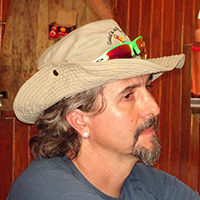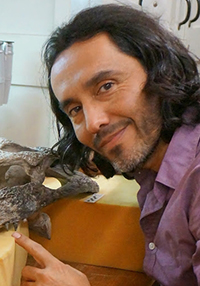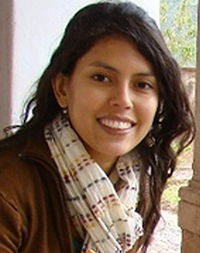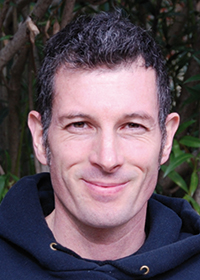 Myriam Boivin. Laboratoire de Paléontologie, Institut des Sciences de l’Évolution de Montpellier (ISE-M, UMR 5554, CNRS/UM/IRD/EPHE), c.c. 064, Université de Montpellier, place Eugène Bataillon, F-34095 Montpellier Cedex 05, France. myriam.boivin@umontpellier.fr
Myriam Boivin. Laboratoire de Paléontologie, Institut des Sciences de l’Évolution de Montpellier (ISE-M, UMR 5554, CNRS/UM/IRD/EPHE), c.c. 064, Université de Montpellier, place Eugène Bataillon, F-34095 Montpellier Cedex 05, France. myriam.boivin@umontpellier.fr
Myriam Boivin is a PhD student and teaching assistant at the University of Montpellier, France, supervised by Pierre-Olivier Antoine and Laurent Marivaux. Her works focus on morphology, phylogeny, and paleobiogeography of Paleogene caviomorph rodents from Peruvian Amazonia.

 Laurent Marivaux. Laboratoire de Paléontologie, Institut des Sciences de l’Évolution de Montpellier (ISE-M, UMR 5554, CNRS/UM/IRD/EPHE), c.c. 064, Université de Montpellier, place Eugène Bataillon, F-34095 Montpellier Cedex 05, France. laurent.marivaux@umontpellier.fr
Laurent Marivaux. Laboratoire de Paléontologie, Institut des Sciences de l’Évolution de Montpellier (ISE-M, UMR 5554, CNRS/UM/IRD/EPHE), c.c. 064, Université de Montpellier, place Eugène Bataillon, F-34095 Montpellier Cedex 05, France. laurent.marivaux@umontpellier.fr
Laurent Marivaux is a CNRS researcher, paleontologist and head of the Paleontology Department at the "Institut des Sciences de l'Evolution de Montpellier". He has a PhD in Vertebrate Paleontology from the University of Montpellier. His research focuses on macroevolutionary, phylogenetic, historical biogeography and paleobiological aspects of the early Tertiary adaptive radiations of some mammal groups (especially Rodentia, Primates, Dermoptera and Chiroptera, and others in collaboration), with a special emphasis on the role of the geodynamic and paleoenvironment changes on their emergence, dispersals and evolution. His is primarily a field paleontologist working in Paleo- and Neotropics.

 Maëva J. Orliac. Laboratoire de Paléontologie, Institut des Sciences de l’Évolution de Montpellier (ISE-M, UMR 5554, CNRS/UM/IRD/EPHE), c.c. 064, Université de Montpellier, place Eugène Bataillon, F-34095 Montpellier Cedex 05, France. maeva.orliac@umontpellier.fr
Maëva J. Orliac. Laboratoire de Paléontologie, Institut des Sciences de l’Évolution de Montpellier (ISE-M, UMR 5554, CNRS/UM/IRD/EPHE), c.c. 064, Université de Montpellier, place Eugène Bataillon, F-34095 Montpellier Cedex 05, France. maeva.orliac@umontpellier.fr
Maëva J. Orliac is a CNRS researcher at the University of Montpellier, France. She is a vertebrate paleontologist devoted to Cenozoic mammal evolution and phylogeny. She completed her undergraduate training and her PhD at the University Pierre et Marie Curie, in Paris. Her work primarily focused on the morphology and systematics of suoids (pigs and peccaries) and hippos, and their relationships within Artiodactyla. She is currently working on endocranial features of extinct and extant ungulates and primates, such as the middle and inner ear, and brain morphology. Recent fieldwork has taken her to Cenozoic deposits of Turkey and Peruvian Amazonia.

 Francois Pujos. Instituto Argentino de Nivología, Glaciología y Ciencias Ambientales (IANIGLA), CCT-CONICET-Mendoza, Av. Ruiz Leal s/n, Parque Gral. San Martín, 5500 Mendoza, Argentina. fpujos@mendoza-conicet.gob.ar
Francois Pujos. Instituto Argentino de Nivología, Glaciología y Ciencias Ambientales (IANIGLA), CCT-CONICET-Mendoza, Av. Ruiz Leal s/n, Parque Gral. San Martín, 5500 Mendoza, Argentina. fpujos@mendoza-conicet.gob.ar
François Pujos is a former Researcher of the French Institute of Andean Studies (IFEA) and currently Senior Researcher of the Argentinean Scientific and Technical National Research Council (CONICET). As a geologist and paleomammalogist, he focuses on systematics, evolution, and paleobiogeography of South American Cenozoic mammals (e.g., Xenarthra). He has organized 25 field missions in several countries of South America (i.e., Argentina, Bolivia, Brazil, and Peru). As a collaborator on a multidisciplinary team, he has participated in the discovery of several new vertebrate communities in the Bolivian Altiplano and Peruvian Amazon and described new taxa, including several ground sloths.

 Rodolfo Salas-Gismondi. Departamento de Paleontología de Vertebrados, Museo de Historia Natural - Universidad Nacional Mayor San Marcos (MUSM), Av. Arenales 1256, Lima 11, Peru. rsalasgismondi@gmail.com
Rodolfo Salas-Gismondi. Departamento de Paleontología de Vertebrados, Museo de Historia Natural - Universidad Nacional Mayor San Marcos (MUSM), Av. Arenales 1256, Lima 11, Peru. rsalasgismondi@gmail.com
Rodolfo Salas-Gismondi is founder and head of the Vertebrate Paleontology Department of the San Marcos University Natural History Museum in Lima, Peru. He has a PhD from the Institut des Sciences de l'Evolution, University of Montpellier, France. He is currently at the Smithsonian Tropical Research Institute, Panama. His research was first devoted to the evolution of South American vertebrates, mainly terrestrial and aquatic mammals (Pacific Coast, Andean highlands, and Amazonia). His current research is focused in the systematics, ecology, and evolution of the crocodylians from the Tertiary of Amazonia.

 Julia V. Tejada-Lara. Departamento de Paleontología de Vertebrados, Museo de Historia Natural - Universidad Nacional Mayor San Marcos (MUSM), Av. Arenales 1256, Lima 11, Peru, and Department of Earth and Environmental Sciences, Columbia University in the City of New York and Division of Paleontology, American Museum of Natural History, Central Park West at 79th Street, New York, NY 10024, USA. julia.tejada@columbia.edu
Julia V. Tejada-Lara. Departamento de Paleontología de Vertebrados, Museo de Historia Natural - Universidad Nacional Mayor San Marcos (MUSM), Av. Arenales 1256, Lima 11, Peru, and Department of Earth and Environmental Sciences, Columbia University in the City of New York and Division of Paleontology, American Museum of Natural History, Central Park West at 79th Street, New York, NY 10024, USA. julia.tejada@columbia.edu
Julia Victoria Tejada-Lara is a PhD student at the Department of Earth and Environmental Sciences at Columbia University, New York. She holds a Master's degree from the Department of Zoology (University of Florida) and a BSc from the National University of San Marcos, Peru. She is Associate Researcher at the French Institute of Andean Studies and at the Natural History Museum in Lima, Peru. Her research has focused on the evolution of Cenozoic mammal communities and ecosystems from Proto-Amazonia and the Andean Plateau. Current research combines systematics, paleogeography, stable isotope geochemistry, and paleoecology of extinct and modern mammals from South America.

 Pierre-Olivier Antoine. Laboratoire de Paléontologie, Institut des Sciences de l’Évolution de Montpellier (ISE-M, UMR 5554, CNRS/UM/IRD/EPHE), c.c. 064, Université de Montpellier, place Eugène Bataillon, F-34095 Montpellier Cedex 05, France. pierre-olivier.antoine@umontpellier.fr
Pierre-Olivier Antoine. Laboratoire de Paléontologie, Institut des Sciences de l’Évolution de Montpellier (ISE-M, UMR 5554, CNRS/UM/IRD/EPHE), c.c. 064, Université de Montpellier, place Eugène Bataillon, F-34095 Montpellier Cedex 05, France. pierre-olivier.antoine@umontpellier.fr
Pierre-Olivier Antoine is a Professor of Paleontology at the University of Montpellier, France. He has a PhD from the Muséum National d'Histoire Naturelle, Paris and he was formerly Associate Professor in the University of Toulouse, France. His research was primarily devoted to Cenozoic mammal evolution, combining phylogenetic analyses and fieldwork in remote areas from Eurasia and South America. Major focuses of his current research are balanced between Cenozoic stratigraphy, biochronology, and paleogeography in Eurasia, and Proto-Amazonian biodiversity and ecosystem dynamics in South America. He has participated in more than 40 field expeditions in Pakistan, Turkey, Peru, and Bolivia.

